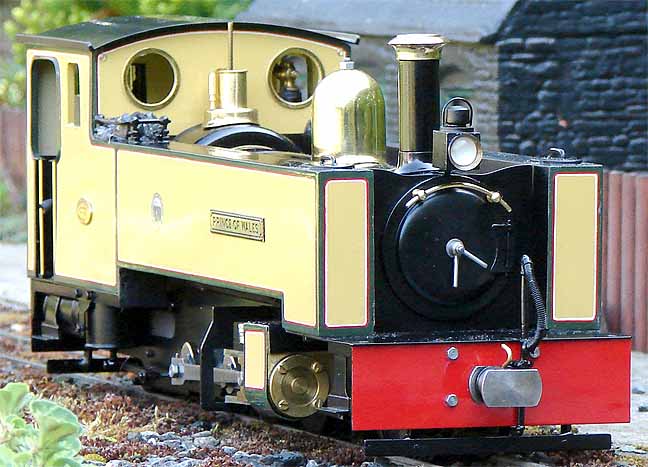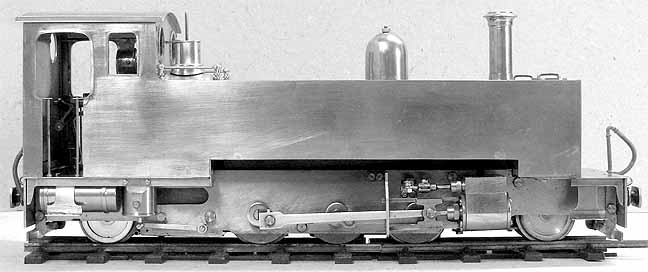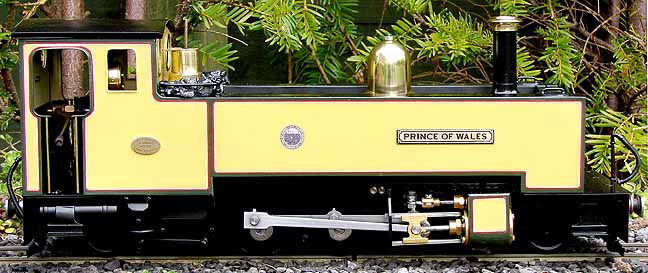Back to Sidestreet Bannerworks
Click here to find out how your engine can be featured!
.


Davies & Metcalfe
Vale of Rheidol 2-6-2
by Keith Skillicorn
Southport, England
Photos by the author
December, 2012
Davies & Metcalfe supplied two, 2-6-2 tank locomotives to the Vale of Rheidol Railway in 1902. One was named Edward VII while the other was called Prince of Wales. They were to be the only two locomotives to be produced by the company who specialized in producing injectors.
The engines gave Starling service throughout the independent years of the railway and into the Cambrian period. The Great Western Railway took over at grouping and spent a considerable sum of money on the engines to bring them up to standard.
These engines did have their failings, however, one of which was the Gooch valve gear. This was placed between the frames and the driving wheels. When the springs became worn, there was a tendency for the gear to catch on point work, with potentially disastrous results. The coal capacity was very limited and, as can be seen in many photos, the coal was heaped onto the top of the boiler. The Cambrian addressed this by extending the bunkers outwards, giving a much greater capacity. However the design for the Great Western's own locos for the VoR where based very much on the original design with the faults ironed out. The valve-gear problem was solved by substituting Walshaerts gear, placed on the outside of the frames, and the bunker design came straight from the Cambrian extensions given to the earlier locomotives.
The model
The model was built out of a lifelong desire to own an Archangel version of this classic loco. However, I was never able to afford one and, since prices for these locos have increased in line with the resurgence of interest in 16mm “heritage,” I decided that it was now even more unlikely that I would ever own one.
The opportunity to build an engine of my own came about when a couple of friends offered to give me some help and advice on building locomotives, and, just as importantly, the use of workshop facilities.
I designed the engine as a meths-fired pot boiler, based on Jack Wheldon's principles for keeping the heat where it should be by making a firebox enclosing the burner, and insulating the rest of the engine.
I decided that the level of detail would be in keeping with my own ideas about what garden railway-engines should look like. The main thing for me would be to get the size and proportion of the loco correct, and forget about such things as rivets. A good paint job would also be a must.
Roundhouse provided the cylinders and axles, as I thought they represented good value and I knew that they would work! Most of the rest of the engine, however, was made from scratch.
There were a few problems with steaming initially, but they were resolved and I have ended up with a powerful and easy-to-control locomotive. I made a few small additions to the traditional pot-boiler design, such as a water gauge and water top-up valve. The engine can be kept in steam all day, if necessary, by giving it a squirt of water and meths at the appropriate times.
The run
Being a pot-boilered loco, Prince of Wales is a particularly easy engine to run. First, the engine is oiled all round, with particular attention being given to the valve gear. The loco has to be inverted to do this, as the gear is sandwiched between the driving wheels and the mainframes. The hydrostatic lubricator is also taken care of.
The boiler is then filled via the top-up valve located within the cab. The level can then be checked with the water gauge, situated right next to it. The meths tank is then filled and the burner lit from beneath.
The loco takes about seven minutes from cold to blow off at 60psi. The safety valve is an old Archangel one that has the most satisfying raspberry as it releases the steam. Wicks are set particularly low on this engine and there is hardly any smell, which shows good combustion is occurring.
The condensate is cleared quickly and the train is coupled up. This consists of four Archangel-type bogie coaches, three Ffestiniog bogie coaches, and five four-wheelers. The loco has no trouble pulling this little lot and puffs round the garden in stately fashion.
The water is good for about 45 minutes, with a quick top-up of meths half way through. When the water is on the “bottom nut” I extinguish the fire and let him cool down. A quick wipe with a rag whilst the engine is still warm gets the oil off the bodywork.
You can see “Prince of Wales” in action below. If, for some reason you can't view the video, click here.
|
|
|
| Builder | Keith Skillicorn (UK) |
| Date completed | 2012 |
| Gauge | 0 (32mm) |
| Scale | 16mm = 1'0" |
| Boiler type | Pot with Wheldon-type firebox |
| Fittings | Steam regulator, safety valve, water gauge, pressure gauge, top-up valve |
| Blowoff pressure | 60 psi |
| Fuel | Alcohol |
| Cylinders | Two, double-acting D-valve from Roundhouse |
| Reversing gear | Slip eccentrics |
| Lubricator | Displacement |
| Dimensions | Length over buffers, 389mm; width over cylinders, 110mm, coupled wheelbase, 96mm; height to top of chimney, 142mm |
| Weight | 10 pounds |

Below: A similar shot of the engine, resplendent in its new paint.






Back to Sidestreet Bannerworks
Click here to find out how your engine can be featured!
This page and its contents
Copyright Sidestreet Bannerworks, 2012